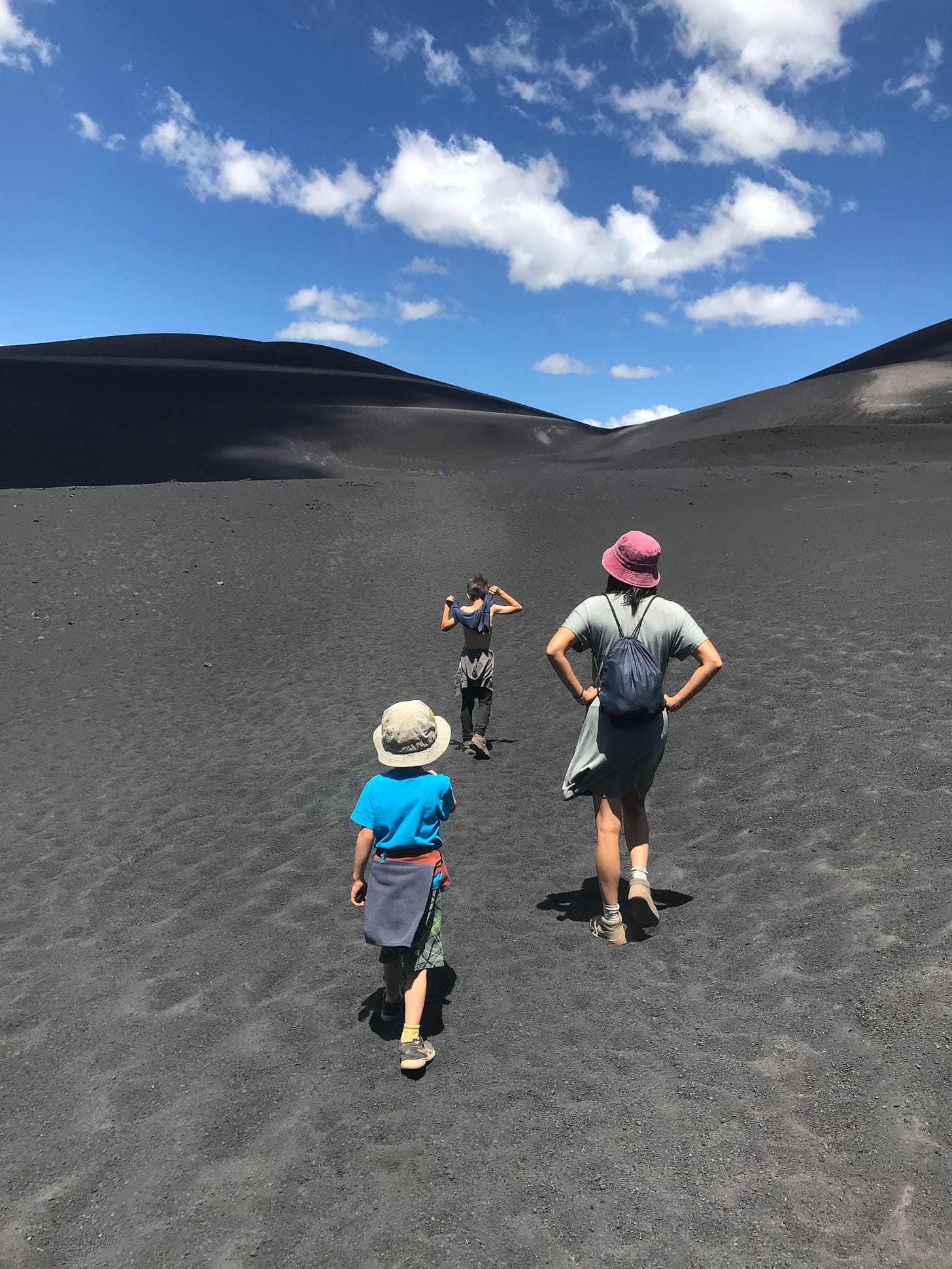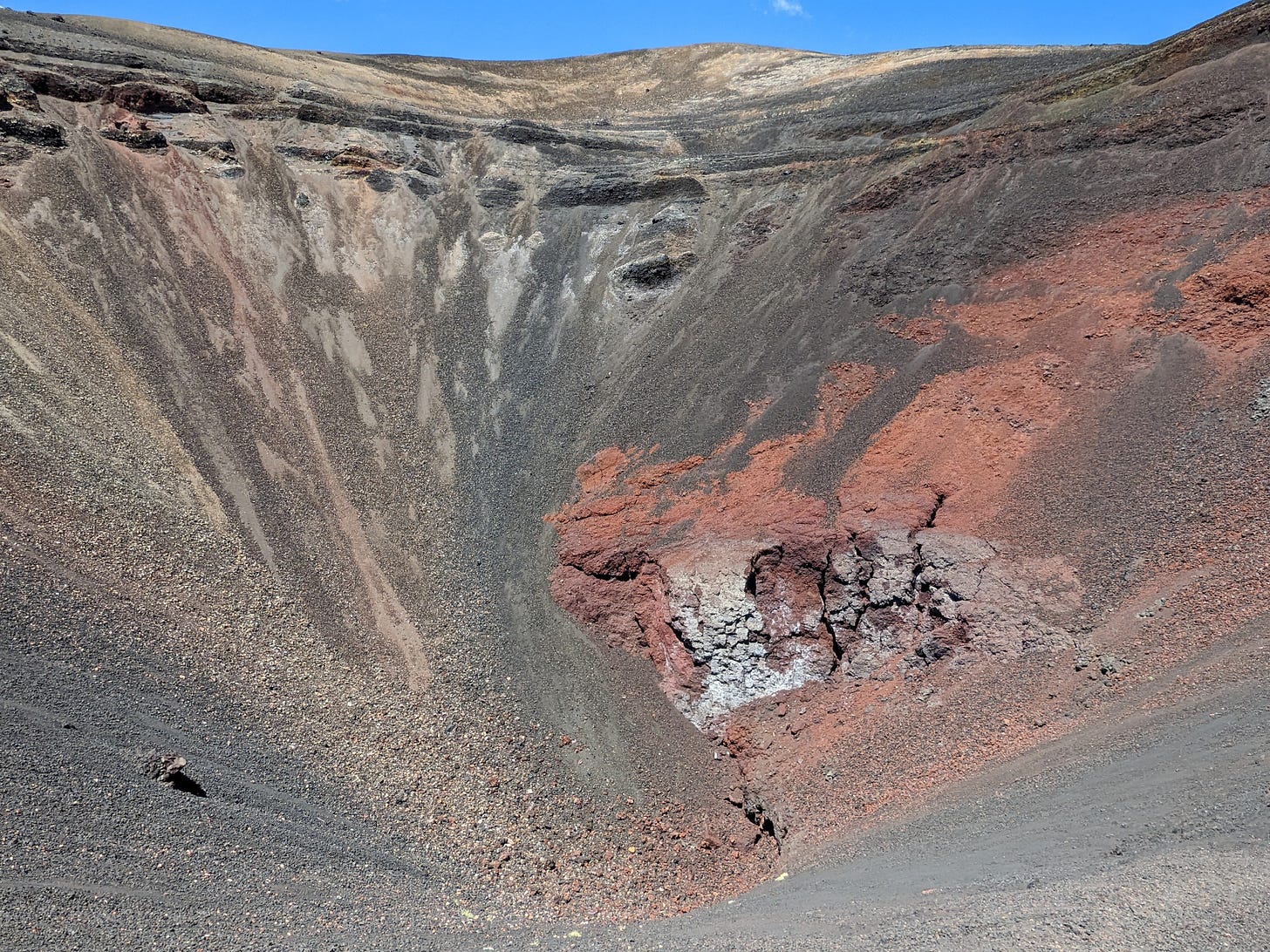Our Family Hike Into Chile’s Crater de Navidad

With our three young boys, we hiked through a landscape transformed by a recent volcanic eruption. Though more than half way through our yearlong trip around South America, it filled us with wonder. It was also the ultimate worldschooling field trip.
Instantly, I noticed what was lacking: all signs of life.
Our drive to the Lonquimay volcano, buried deep in the Andes, was like traveling back through Earth’s prehistoric epochs. Wheat fields gave way to Araucaria (a.k.a. monkey puzzle tree) forests. The long spindly branches of this Chilean pine cantilever horizontally from the trunk, as if this were nature’s very first attempt at designing a tree.
Driving further from civilization, we were flanked on both sides by ancient flora. I half expected to spot a dinosaur grazing in the brush.
And just like that, we turned off onto a gravel road and left Earth’s veneer of flora and fauna behind. The landscape was as barren as Mars. Even vast parking lots have weeds pushing through the cracks. Deserts have cacti, scrubs, and scorpions. The absence of anything living was otherworldly. I imagined that this is what Earth looked like before multicellular life.
Lonquimay Gives Birth
The valley wasn’t always devoid of life. In 1988, on Christmas day (Liuan had just turned one year old the day before), a violent explosion birthed another volcano in the side of Lonquimay—the Crater de Navidad (the Christmas Crater). Red hot rocks shot straight upward, sometimes exploding in mid-air, while a lava flow covered the valley for the entirety of 1989, and did not stop until January 1990. (Here is a wonderfully vintage blog post by someone who witnessed it back in 1989.)
Since the area is quite remote, very few people died. Many cattle, however, perished from the plume of ash that settled far and wide.

Thank You To Our Friend Who Lent Us Her Car
Cristina, our host at a farm in Central Chile (which I wrote about here), told us this hike would be unforgettable. She lent us her car, apologizing that it was a piece of junk, and sketched out the directions on a piece of paper. We thanked her for her generosity, notwithstanding the condition of the car.
Using a combination of the sketch and Google maps, we found our way to the “trail,” which was little more than a series of blue posts stretching out into the void.
As we bumped and rattled over the unpaved road, I said a prayer for our generous host’s car. This was not the place for a break down.
The Snow Is Just Over There!
We left the car on the edge of a road that was etched into a mountainside. The mountain resembled a pile of gravel from the perspective of an ant.
We descended into the valley following the blue posts, each one barely within view of the last.
The hike was tiring. The loose rocks and gravel sapped energy from our legs. The sun seared our ears and necks and the unobstructed wind fought against us. There was no shade except when a cottony cloud would float overhead providing temporary relief.
As we rounded the enormous girth of Lonquimay, Liuan set her gaze on the snow pack resting on its upper cone. “We should go over there and touch the snow!” Liuan announced, and started off perpendicular to the trail. The boys followed.
In her defense, it really did appear that the snow was a mere ten to fifteen minutes away. But it had to be a mirage. It was a blazing ninety degrees where we stood. To get from ninety to freezing (32°C to 0°C) was not going to be a quick stroll.
Liuan would not be persuaded. This was a once in a lifetime opportunity, she insisted. Twenty minutes later, we were losing steam. The snow still appeared close, but not any closer than it was when we started. The boys were starting to see it my way. One by one we peeled off from the group and headed back toward the trail. Liuan reluctantly followed.

The Grueling Ascent
Climbing up the side of a recently active volcano is not like hiking up your typical mountain. It’s more like scrambling up a giant pile of loose Legos. Unlike land that has rested for geological ages, nothing is cemented down.
Worse still, we couldn’t get a view of the top. After nearly an hour of winding upward with no end in sight, Liuan had had enough. She sat down on a rock and told us we could continue without her. Miles (3 years old) stayed behind while Oliver (9), Finley (6) and I continued on.
Without the stragglers, we proceeded to jog the rest of the way. Happily, we were closer to the rim than we thought and reached it in under five minutes.
We planned to go back and tell Liuan and Miles they were almost there, but not before taking in the terrible wonder that lay before us.
A Funnel to the Underworld
Behind us, the valley stretched out to infinity. A river of charcoal gray rocks stretched out toward the purple Andes skyline and green forest on the horizon. We were bugs crawling over a bulldozer’s trail of destruction.
The crater in front of us was like a funnel. I spotted the pitch black hole surrounded by a jagged archway in reddish stone. It’s the doorway to hell, I muttered. Then my eyes followed the steep slippery ridge that connected where we stood to that hideous orifice. I envisioned myself shuffling down to get a close-up photo, losing traction, and sliding to my doom.
“Do NOT go any closer!” I growled at the boys, just in case they were imagining it too.
Before heading back down to get Liuan and Miles, there was one more thing that couldn’t wait. I picked up a stone and tossed into the black abyss. It ping-ponged off the sides for what seemed like over half a minute, each time more distant and faded. We never heard it hit bottom.














